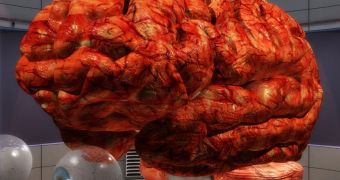The brain is constantly working; even when we sleep, neural waves cross our brain, inducing fluctuating, unstable patterns.
These waves make 98 % of the brain activity, but many consider them just background. A new research has come to explain their role and what the resting brain does.
"Some people see the brain in terms of inputs and outputs, like a computer. If you provide an input, you'll get a particular output," said Cristopher Honey, a doctoral student in Indiana University Bloomington's Department of Psychological and Brain Sciences.
"We believe that even in the absence of an external stimulus, there are very important processes going on in the brain which affect the stimulus-responses that the brain will produce. We believe that ongoing spontaneous activity should be studied in itself. Other researchers consider this to be unimportant 'noise' that should be filtered out."
The team made a large-scale computer model of the brain of a macaque monkey, showing that the shape and the pattern of the waves are linked to the brain's specific wiring pattern (neuroanatomy). Slow 5- 10 seconds fluctuations of activity resulted naturally from much faster, chaotic neural interactions which emerge for just a few milliseconds.
"Our model suggests that the cortical resting state is not time-invariant, but instead contains rich and interrelated temporal structure at multiple time scales that is shaped by the underlying structural topology," wrote the authors.
When you read a book or chat, the tasks solicit just 2 - 5 % of the total brain activity. But similar fluctuations occur when you do nothing.
"The nature of these "resting state fluctuations" is an active topic of research in cognitive neuroscience, with their mysterious origin prompting one prominent researcher to label them the "brain's dark energy," said Olaf Sporns, associate professor in the Department of Psychological and Brain Sciences
Even today, neuroscientists know relatively little about the structure of the human brain, like the hundreds (the precise number is undetermined) of the human brain regions and how they are connected. The new computer model points that the pattern of connectivity is essential to inducing and shaping brain activity in the resting and active brain.
The team is going to create a similar large-scale computer model of the human brain to investigate larger networks and connectivity, when the required data of how human neuron networks are modeled will be available. This way neural waves could be linked to cognitive and behavioral performance and brain differences could be linked to individual judgements.
"This research could lead to clinical applications, offering new diagnostic tools for brain disorders such as Alzheimer's disease that are known to affect the brain's connections. It also could help explain why humans do not think alike. If fluctuations in brain activity are shaped by anatomy, then individual differences in the way people think and what they think about could be rooted in differences in the way their brains are connected," said Sporns.

 14 DAY TRIAL //
14 DAY TRIAL //